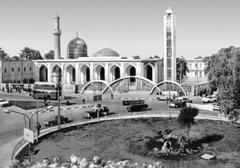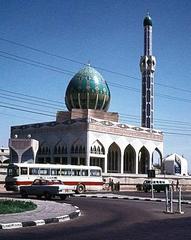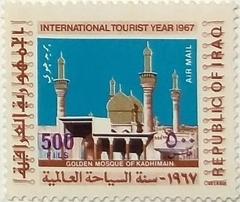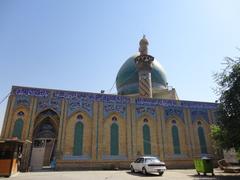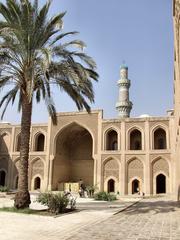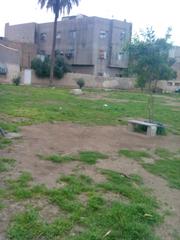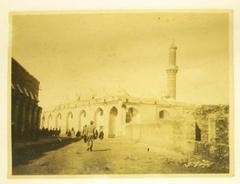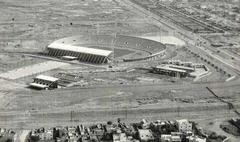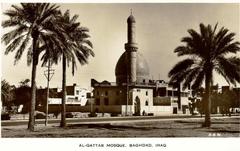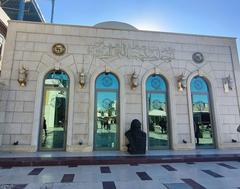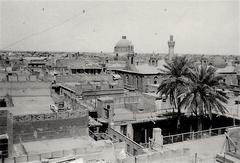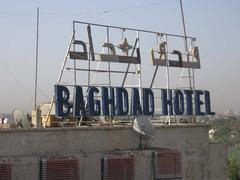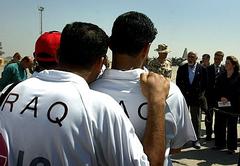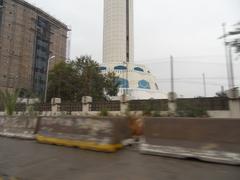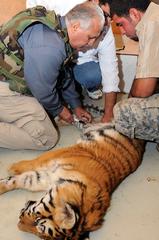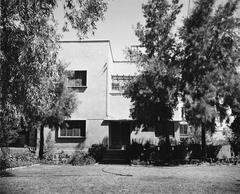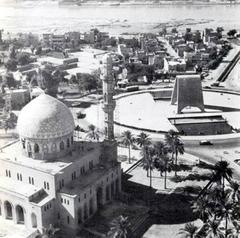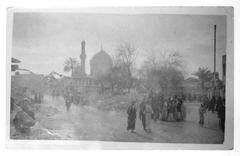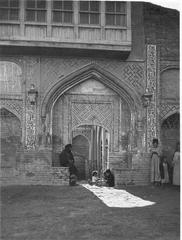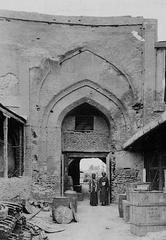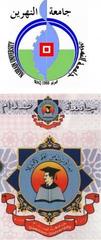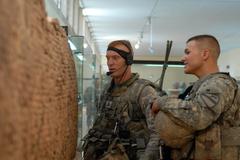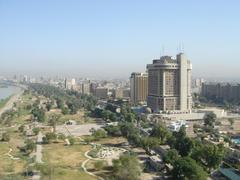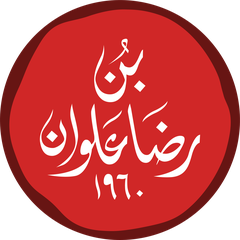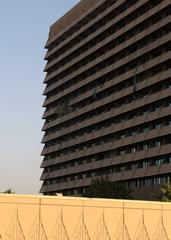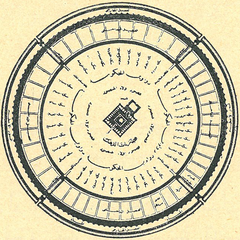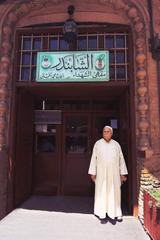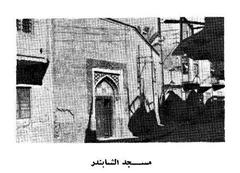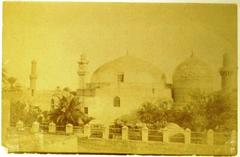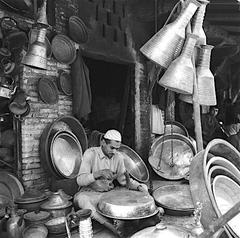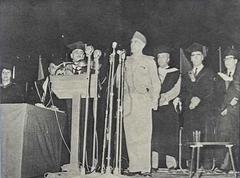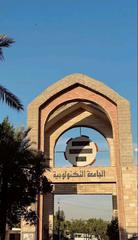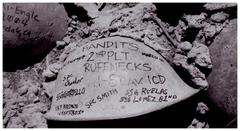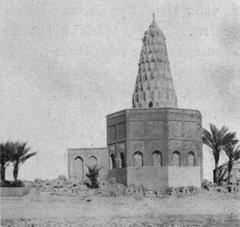Shaduppum (Tell Harmal) Baghdad: Visiting Hours, Tickets, and Historical Sites Guide
Date: 14/06/2025
Introduction: History and Significance of Shaduppum (Tell Harmal)
Situated near present-day Baghdad, Iraq, the ancient city of Shaduppum—better known as Tell Harmal—is a striking example of Mesopotamian urban, administrative, and scholarly achievement. Originating in the late third millennium BCE, Shaduppum served as a fortified administrative hub within the powerful kingdom of Eshnunna, strategically positioned along the Diyala River. Its Akkadian name translates to “the accountant’s office” or “the treasury,” highlighting its foundational roles in governance and economic management (indroyc.com; wikipedia).
The city reached its zenith during the Old Babylonian period (circa 2000–1600 BCE), becoming a vibrant center for administration, religion, and learning. Excavations at Tell Harmal have revealed advanced urban planning, defensive walls, temples—including a prominent one dedicated to Nisaba, the goddess of writing—and a trove of nearly 3,000 cuneiform tablets. These tablets provide a window into the legal, mathematical, and literary life of ancient Mesopotamia, emphasizing Shaduppum’s status as a hub of intellectual and cultural activity (100hala-iq.com; uruk-warka.dk).
Although less developed for tourism than sites like Babylon or Ur, Shaduppum remains a site of great historical value. Artifacts from the city are preserved in the National Museum of Iraq in Baghdad, and the region offers further opportunities for exploring Mesopotamian heritage. This guide offers a thorough overview of Shaduppum’s history, archaeological discoveries, practical visitor information, and tips for experiencing this unique site (Unusual Traveler; Against the Compass).
Contents
- Origins and Early Development
- Rise to Prominence in the Old Babylonian Period
- Urban Layout and Architectural Features
- Intellectual and Religious Significance
- Political Shifts and Decline
- Rediscovery and Archaeological Legacy
- Visitor Information
- Visiting Hours and Tickets
- Accessibility
- Getting There
- Best Times to Visit
- Nearby Attractions and Accommodations
- Guided Tours and Special Events
- Frequently Asked Questions (FAQ)
- Planning Your Visit & Further Resources
1. Origins and Early Development
Shaduppum’s roots extend back to the late third millennium BCE, with archaeological evidence pointing to its foundation as a fortified settlement in the Diyala River region, about 75 kilometers from modern Baghdad (indroyc.com; wikipedia). As part of the kingdom of Eshnunna, its role as an administrative and economic center is reflected in its name and the early occupation layers, which reveal planned urban spaces, defensive walls, and public buildings (100hala-iq.com).
2. Rise to Prominence in the Old Babylonian Period
The city flourished during the Old Babylonian period, thanks to its strategic location and integration into regional networks alongside cities such as Eshnunna and Tell Ishchali (wikipedia). Excavations since 1945 have unearthed almost 3,000 cuneiform tablets documenting administrative, legal, and religious aspects of life (uruk-warka.dk; 100hala-iq.com).
3. Urban Layout and Architectural Features
Shaduppum was built as a heavily fortified, irregular rectangle with robust defensive barriers. Five distinct occupation layers have been identified, with the latest dating to the Kassite period. Within the walls, archaeologists discovered private residences, administrative buildings, and seven temples. The largest was dedicated to Nisaba and her consort Haia, its entrance guarded by terra-cotta lions now exhibited in the National Museum of Iraq (indroyc.com).
4. Intellectual and Religious Significance
The site’s cuneiform tablets reveal a sophisticated legal system, with some records predating the Code of Hammurabi (pleiades.stoa.org). Mathematical and literary texts—including myths, hymns, and epics—underscore the city’s role as an intellectual center (100hala-iq.com). The temple of Nisaba doubled as a scribal school, solidifying the city’s status in education and record-keeping (indroyc.com).
5. Political Shifts and Decline
Shaduppum’s fortunes mirrored the region’s shifting political landscape. Its prosperity waned with the rise of Babylon and subsequent geopolitical changes. By the Late Babylonian period, it was abandoned, its ruins gradually reclaimed by the landscape (indroyc.com).
6. Rediscovery and Archaeological Legacy
Rediscovered in the mid-20th century, Tell Harmal has been pivotal in advancing our understanding of Mesopotamian urbanism, administration, and law (uruk-warka.dk). Thousands of tablets and numerous artifacts from the site are studied and displayed globally.
7. Visitor Information
Visiting Hours and Tickets
Tell Harmal (Shaduppum) is accessible, but hours may vary due to preservation and security concerns. Confirm current opening times and ticket prices with local tourism offices or the Iraqi Ministry of Culture. Typical hours are 8:00 AM–5:00 PM, with tickets for international visitors around 3,000 IQD; discounts are available for locals and students.
Accessibility
The site features uneven ground and partially excavated ruins. While some ramps exist, accessibility for visitors with mobility impairments is limited. Guided tours can be arranged to assist with access.
Getting There
Located about 75 kilometers from Baghdad, Tell Harmal is reachable by car or arranged tour—expect a 1.5 to 2-hour journey. Public transport is limited; private transport or tours are recommended (Unusual Traveler).
Best Times to Visit
Visit between October and April for milder weather. Early mornings and late afternoons are ideal for photography and comfort.
Nearby Attractions and Accommodations
Explore nearby sites such as Eshnunna and Tell Ishchali. Baghdad offers a range of hotels, from budget to luxury. The National Museum of Iraq is a must-see for artifacts from Shaduppum and other ancient cities.
Guided Tours and Special Events
Guided tours are available through local agencies and cultural organizations. Occasionally, educational workshops and cultural events take place on-site (RJ Travel Agency).
8. Frequently Asked Questions (FAQ)
Q: What are the opening hours?
A: Typically 8:00 AM–5:00 PM, but confirm with local authorities.
Q: Is the site accessible for people with disabilities?
A: Accessibility is limited; contact tour providers for assistance.
Q: Are guided tours available?
A: Yes, through local agencies.
Q: How do I get there from Baghdad?
A: About a 1.5–2 hour drive; private transport or tours are advised.
Q: Are there entrance fees?
A: Yes, usually about 3,000 IQD; discounts may apply.
9. Planning Your Visit & Travel Tips
Entry and Documentation
Obtain a visa prior to arrival; visa-on-arrival is limited to select countries. Carry multiple copies of important documents (TravelSetu).
Safety and Health
Monitor government travel advisories (Travel Like a Boss). Use reputable guides, avoid high-risk areas, and ensure you are up-to-date on vaccinations. Drink bottled water and eat at established restaurants.
Cultural Etiquette
Dress modestly, respect local customs, especially during Ramadan, and ask permission before photographing locals.
Accommodation & Money
Baghdad offers a range of accommodations, from luxury hotels to budget options (Adventures of Lil Nicki). Use Iraqi Dinar; carry cash in small denominations.
Connectivity
Purchase a local SIM card (Zain Iraq or Asiacell) and download offline maps and translation apps.
Packing Essentials
Bring modest clothing, sun protection, sturdy shoes, personal health items, and digital copies of documents.
Emergencies
Know your embassy’s location and the nearest medical facilities (WorldGateIQ).
10. Photographic Spots and Accessibility
The site offers excellent photography opportunities at sunrise and sunset. For those with mobility needs, contact the site in advance for information on access.
11. Responsible Tourism
Respect the archaeological site by not removing artifacts, following all guidelines, and supporting local economies through authentic purchases.
12. Summary and Final Visitor Tips
Shaduppum (Tell Harmal) stands as a testament to the administrative, religious, and intellectual achievements of ancient Mesopotamia. While the site itself may present challenges for direct visitation, the broader Baghdad region offers rich opportunities to engage with Iraq’s ancient legacy. Careful planning—regarding transportation, permits, and guides—will help ensure a safe and rewarding experience. Support ongoing preservation efforts by visiting museums, participating in cultural events, and using responsible travel practices (Unusual Traveler; Against the Compass).
References
- indroyc.com
- mapcarta.com
- RJ Travel Agency
- Unusual Traveler
- Against the Compass
- TravelSetu
- Travel Like a Boss
- Adventures of Lil Nicki
- uruk-warka.dk
- wikipedia
- 100hala-iq.com
- WorldGateIQ
Images and media are recommended for a richer experience. Use descriptive alt text for SEO and accessibility, e.g., “Terra-cotta lions at Shaduppum temple” or “Map of Tell Harmal near Baghdad.”
For further exploration, download the Audiala app and follow our social channels for updates and travel inspiration.
